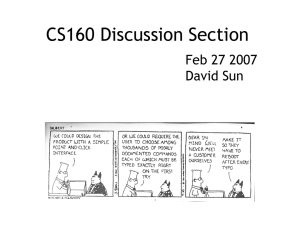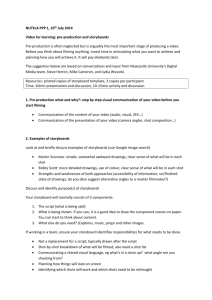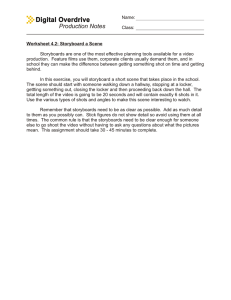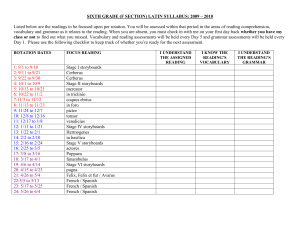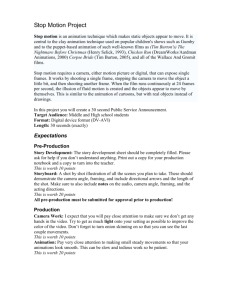Storyboards - Quick Reference ☞ Communication Technology
advertisement
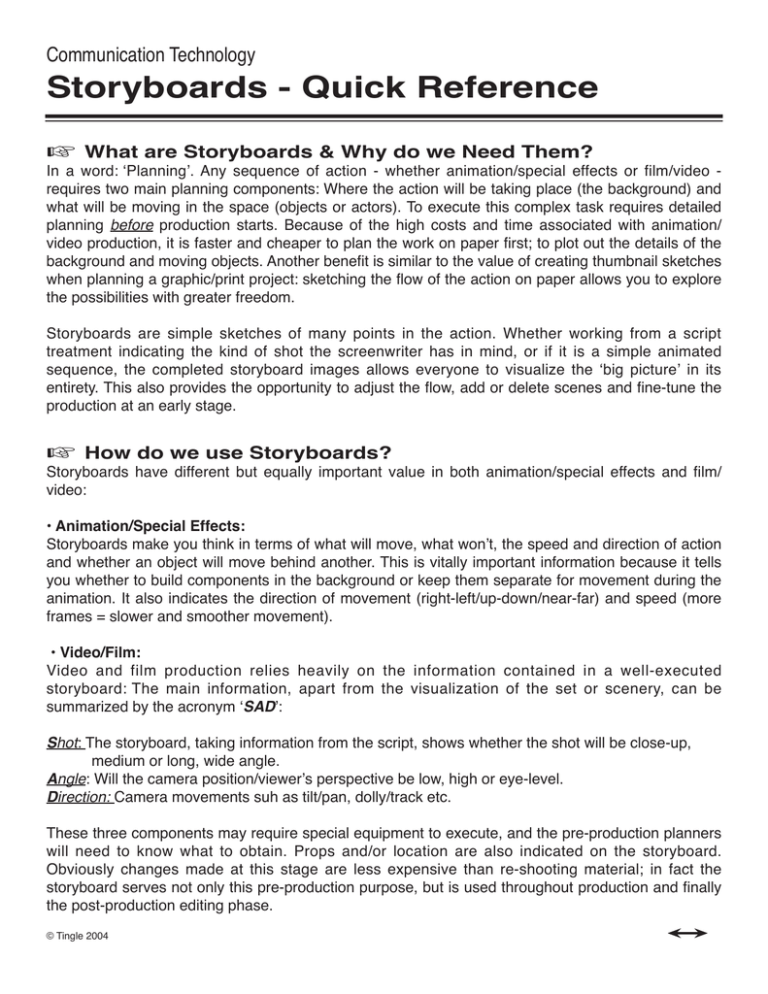
Communication Technology Storyboards - Quick Reference ☞ What are Storyboards & Why do we Need Them? In a word: ‘Planning’. Any sequence of action - whether animation/special effects or film/video requires two main planning components: Where the action will be taking place (the background) and what will be moving in the space (objects or actors). To execute this complex task requires detailed planning before production starts. Because of the high costs and time associated with animation/ video production, it is faster and cheaper to plan the work on paper first; to plot out the details of the background and moving objects. Another benefit is similar to the value of creating thumbnail sketches when planning a graphic/print project: sketching the flow of the action on paper allows you to explore the possibilities with greater freedom. Storyboards are simple sketches of many points in the action. Whether working from a script treatment indicating the kind of shot the screenwriter has in mind, or if it is a simple animated sequence, the completed storyboard images allows everyone to visualize the ‘big picture’ in its entirety. This also provides the opportunity to adjust the flow, add or delete scenes and fine-tune the production at an early stage. ☞ How do we use Storyboards? Storyboards have different but equally important value in both animation/special effects and film/ video: • Animation/Special Effects: Storyboards make you think in terms of what will move, what won’t, the speed and direction of action and whether an object will move behind another. This is vitally important information because it tells you whether to build components in the background or keep them separate for movement during the animation. It also indicates the direction of movement (right-left/up-down/near-far) and speed (more frames = slower and smoother movement). • Video/Film: Video and film production relies heavily on the information contained in a well-executed storyboard: The main information, apart from the visualization of the set or scenery, can be summarized by the acronym ‘SAD’: Shot: The storyboard, taking information from the script, shows whether the shot will be close-up, medium or long, wide angle. Angle: Will the camera position/viewer’s perspective be low, high or eye-level. Direction: Camera movements suh as tilt/pan, dolly/track etc. These three components may require special equipment to execute, and the pre-production planners will need to know what to obtain. Props and/or location are also indicated on the storyboard. Obviously changes made at this stage are less expensive than re-shooting material; in fact the storyboard serves not only this pre-production purpose, but is used throughout production and finally the post-production editing phase. © Tingle 2004 ☞ How Do We Make Storyboards? Storyboards are comprised of a series of boxes or frames into which simple sketches are drawn to represent the background/scenery and the action elements such as moving objects and actors. Animation storyboards typically show the major positions of objects every five or ten frames.It is not necessary to be an artist, nor is it necessary to draw in every frame of animation. Frames can show movement by drawing an arrow from an object and indicating roughly how many frames the action will take. Film/video storyboards often have the type of shot noted and the transition between frames if there are several shots storyboarded. It is a good idea to number the frames so the viewer follows the action accurately. Pre-printed formats are available for use. Below is a typical storyboard: 1 - Long Shot of House 2 - Zoom to Medium Shot 3 - Pan to Actor Close-Up 4 - Cut to Medium Shot of Street Subject/Type of Shot Camera Direction Transition to New Shot Shot TransitionShot Description Frame/Shot Number ☞ Who uses Storyboards? You can see how such a visual document is valuable for many film/video production people: • Actors see the movement the director has planned; • Site Scouts use it to find proper locations; • Prop people see what kinds of material they will have to get; • Sound Engineers plan the microphones they may need; • Camera people see the lenses and camera dolly/crane/truck equipment they may need; • Lighting crews note the light coverage required, and the type of lighting equipment required; • Special Effects can plan for their involvement; • Stunt people can visualize their needs and advise the producer; • The investors can visualize their entire production at a glance; • The Director uses it as a shooting guide; • The Editor relies upon it to organize the raw footage shot by the Director/Camera crew. For Animation/Special Effects, the following is vital information: • What components will comprise the background; • If tilting or panning, the size of background required; • What objects/elements will be mobile at some point in the action and where; • Which objects/elements will be in the foreground, with other objects moving behind; • Indication of sound synchronization required (dialogue and/or sound effects). © Tingle 2004
